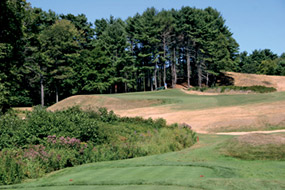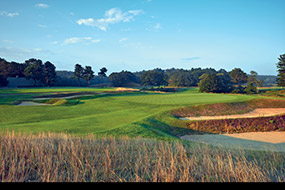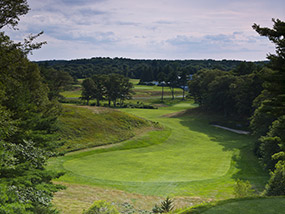Established principally as a horse and leisure club, the Essex County Club was born in 1893 in the small Massachusetts town of Manchester by the Sea. The club’s first course was a basic nine-holer, which was expanded to eighteen in 1917 by the great Donald Ross. Ross had arrived in Boston in 1899 and although he left for Pinehurst the following year, he continued to return to New England during the summers, living at Essex for several years while he oversaw the construction of its new holes.
What makes Essex such an outstanding golf course is its spectacular golf topography and Ross’s willingness to let the bumpy landscape dictate his design. Routing holes to make best use of the terrain, he created a unique links-style layout that mixes some dizzying undulation with an attractive mix of pine and fescue. The greens are generously proportioned but cleverly shaped to play tighter and more complicated than they appear while the rugged bunkering compliments the nature of the property and asks the appropriate range of strategic questions.
Although the inward nine boasts the most exciting land, there are blind drives, hidden greens and wild fairway contours throughout the layout. There are also a large number of clever mid-length par fours. The best two are the 2nd and the 6th, both almost drivable under favorable conditions yet built with nasty crowned greens that demand birdie-seekers take an aggressive line off the tee. The other really interesting outward holes are the 8th, with its blind split level fairway, and the long par five 3rd, which features a unique ‘bathtub’ shaped depression in its green. This target apparently dates back to the original 1893 course and is said to be the oldest continuous green in the country.
The fun on the back nine starts at the 10th, which plays partly across the shoulder of a hill and has plenty of fairway width but a green so steeply angled that it encourages drives out to the narrow left side. Other fine holes include the blind, tumbling 12th and the gorgeous tree-lined 13th, with its crowned target set on a ledge beneath a rocky embankment. The quartet of quirky finishing par fours are also great fun, especially the short 17th, an Alps hole that climbs more than 100 feet, and the longer 18th, which drops even farther over and then around a couple of large hills toward a small, domed green set immediately beyond a brook. The showstopper, however, is the 11th, a stunning Redan-like par three with its green sitting atop a steep plateau and guarded by a series of enormous bunkers.
Essex is a wonderful old golf club and in its rugged, natural state perhaps best reflects how the architect himself would have preferred his more famous courses remain. With the exception of his work at Pinehurst, Ross probably spent more time personally working on these holes than at any other course he designed. Despite its low-profile and absence from major ranking lists, those who can tolerate the bouncy fairways, wild greens and uneven lies will rejoice at having discovered one of golf’s true hidden gems.

 this course also has exceptional:
this course also has exceptional:


